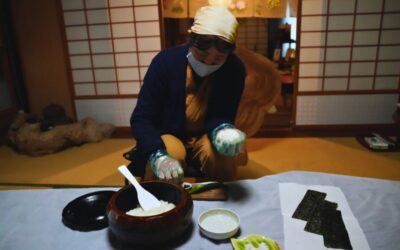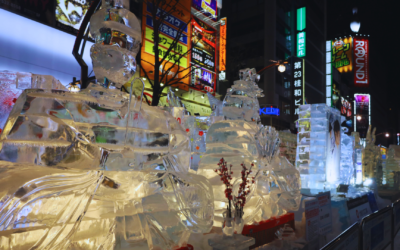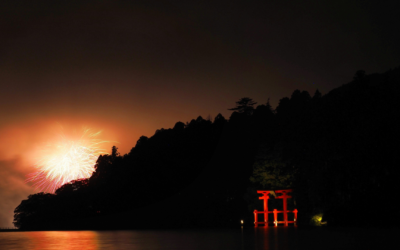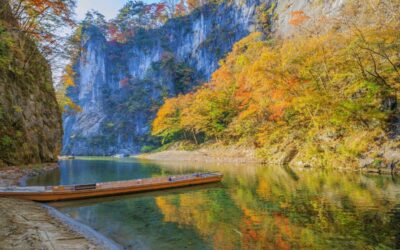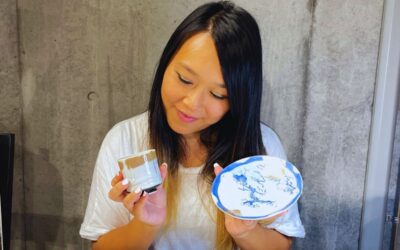If you’ve ever found yourself mesmerised by the flowing lines of a kimono, its delicate patterns, or the centuries of craftsmanship stitched into every fold — welcome, you’re among fellow fans.
The kimono is more than just traditional clothing. It’s a form of art, full of history and meaning, and each one reflects the region, season, and skill of the people who made it. From the bright dyes of Kyoto to the soft, subtle shades of Kanazawa, every kimono has its own story.
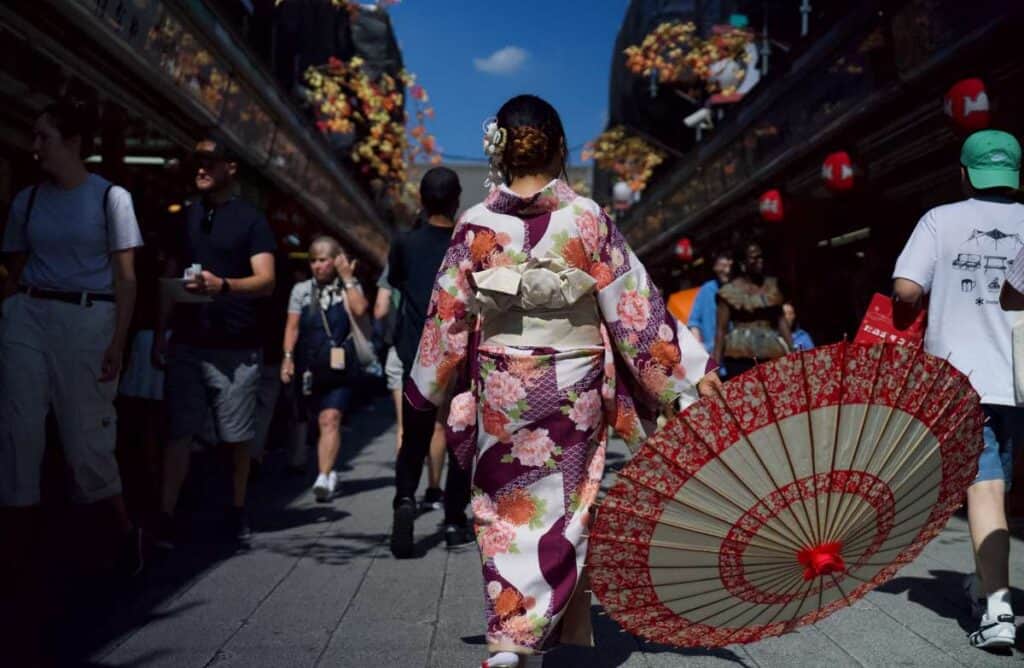
The good news is that there are so many ways to experience kimono culture while you’re in Japan. You can visit museums and studios to learn how kimonos are made, dress up in one and walk through beautiful traditional streets, or shop for something special to take home — maybe even try making a little something yourself. No matter your style, there’s a kimono experience waiting for you.
In this guide, we’ve picked the best places in Japan to: learn about kimonos (like artisan studios and museums), wear them in amazing historical spots, and shop or create your own (from markets to designer shops). Let’s get into it!
Where to Learn About Kimonos in Japan
If you love knowing the why behind what you wear — the history, the techniques, the symbolism — these are the places to go.
Itchiku Kubota Art Museum (Kawaguchiko, Yamanashi)

This place is honestly magical. Set in a peaceful forest near Lake Kawaguchi, with Mt. Fuji peeking through the trees, the Itchiku Kubota Art Museum feels more like a spiritual retreat than a museum. The main draw? Huge, breathtaking kimono “paintings” created using a revived Tsujigahana dyeing technique — a lost art that Kubota brought back to life after years of study.
These kimonos aren’t really meant to be worn; they’re massive works of art that blend colour, texture, and emotion in the most incredible way. One gallery even displays a series designed to represent the seasons and the universe itself. It’s not just a visual experience — it’s one that makes you feel something. If you’re already near Mt. Fuji, don’t miss this spot!
Kyoto Museum of Crafts and Design (Okazaki, Kyoto)

Located under the Miyako Messe building near Heian Shrine, this museum is all about Kyoto’s traditional crafts — from ceramics and lacquerware to textiles and metalwork. The section on Kyo-Yuzen dyeing is especially worth a look, with beautifully displayed kimonos, tools, and videos that walk you through the process from sketch to finished piece.
It’s not a kimono-only space, but the way it puts Kyo-Yuzen in context alongside other crafts makes it a great stop for anyone curious about how deep Kyoto’s design traditions go. Entry is free, it’s well-organised, and there’s often a quiet, calm atmosphere that makes it easy to take everything in. Check ahead — they sometimes have special exhibitions focused just on kimono or textile arts.
This spot pairs well with nearby stops like Heian Shrine, so it’s easy to work into a day of exploring.
Kaga Yuzen Kimono Center (Kanazawa, Ishikawa)
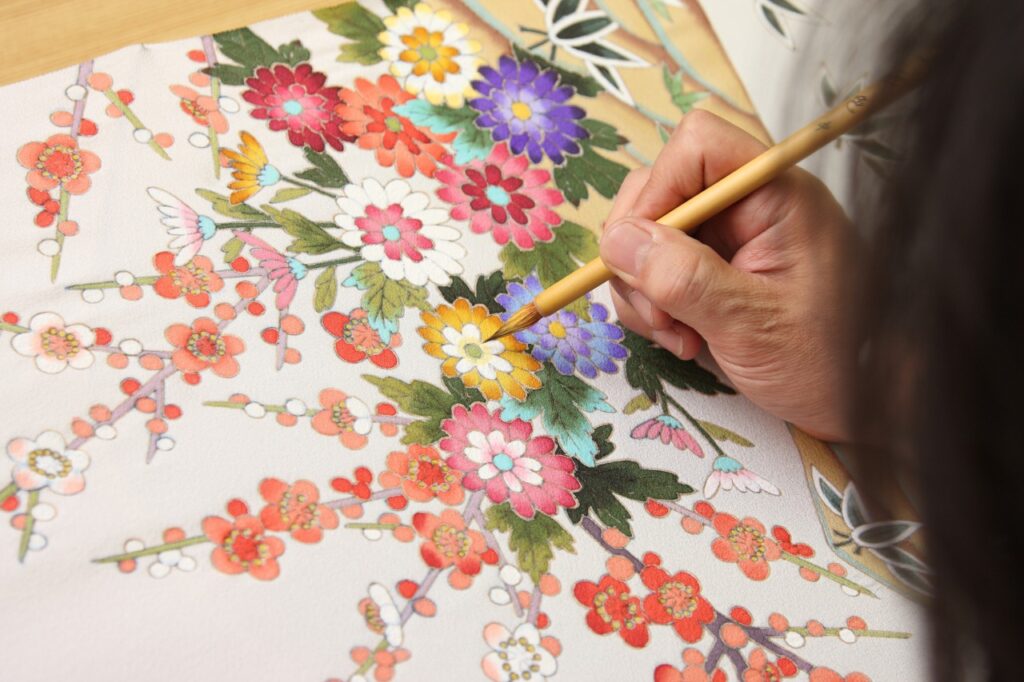
While Kyoto’s style is bold and colourful, Kaga Yuzen is more understated — think natural tones, fine lines, and elegant florals. This centre gives you a front-row seat to the process, with detailed displays and artisan demos that show how each piece comes to life. You can even join a mini workshop and try the dyeing process for yourself.
The location adds to the charm. Kanazawa is full of beautifully preserved Edo-era streets, so once you’ve learned about Kaga dyeing, you can step right into history outside. It’s the perfect pairing of education and atmosphere — plus, the nearby tea houses and gold leaf shops are well worth exploring too.
Where to Dress Up in a Kimono and Explore Traditional Streets
Wearing a kimono in Japan isn’t just about the outfit — it’s about the setting. The places listed below give you the full experience: beautifully preserved streets, temples, gardens, and historic districts that feel like they were made for silk and obi. Rent a kimono nearby and wander through scenery that brings tradition to life.
Sannenzaka & Ninenzaka Streets (Kyoto)
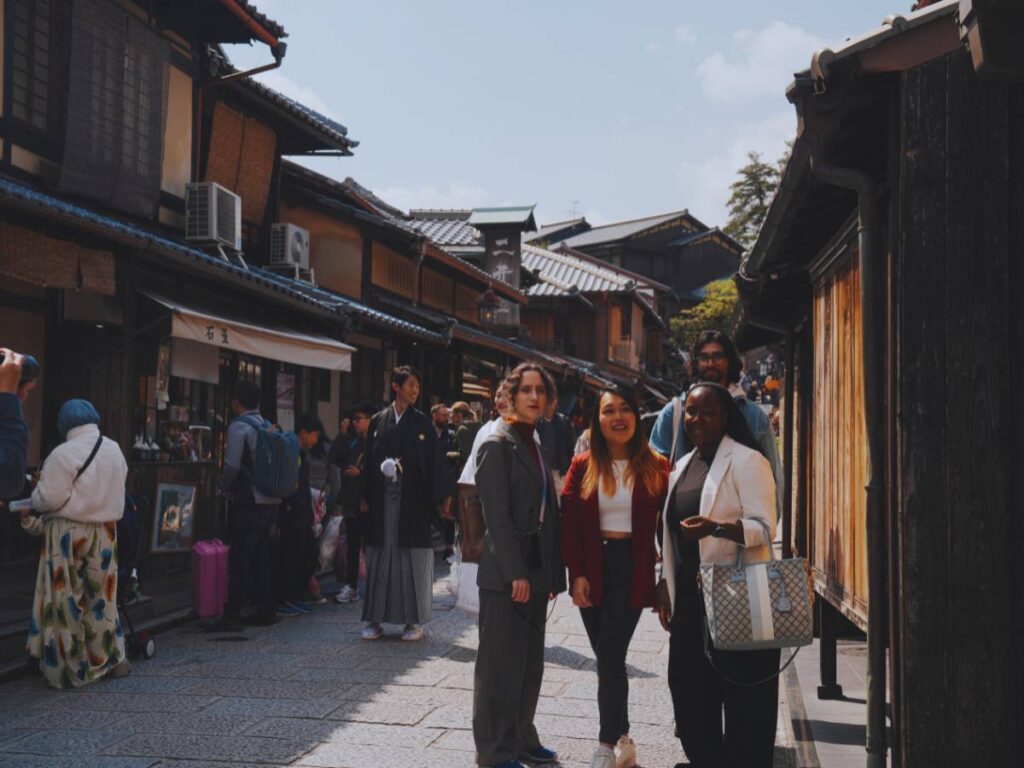
These two gently sloping lanes in Kyoto’s Higashiyama district are some of the most iconic streets in Japan. With their stone-paved paths, wooden machiya townhouses, and little teahouses tucked into corners, they lead you straight toward famous sights like Yasaka Pagoda and Kiyomizu-dera Temple. It’s the kind of place that feels like it hasn’t changed in centuries — and when you’re in a kimono, it just clicks.
You can easily book a kimono wearing experience in this area, offering a full range of styles, seasonal patterns, and add-ons like hair styling and accessories. Once you’re dressed, take your time wandering the streets, stopping for matcha soft serve or traditional sweets. It’s busy, especially in peak seasons, but the atmosphere is part of the charm — you’re surrounded by others also soaking up the same old-school Kyoto vibe.
Kurashiki Bikan Historical Quarter (Okayama)

Kurashiki is often overlooked, but it’s one of the most charming spots to wear a kimono. The Bikan area is full of Edo-period warehouses, narrow alleys, and peaceful canals lined with weeping willows. It has a soft, slow pace that’s perfect for a relaxed stroll, and it feels a bit like stepping into a quiet storybook version of old Japan.
You can rent a kimono nearby and wander on foot or even take a boat ride down the canal — complete with someone gently paddling you past ivy-covered stone bridges. There are also great little museums, art shops, and cafés tucked throughout the district, so you can easily make an afternoon of it. It’s less about crowds and photos here, and more about atmosphere and quiet moments.
Kenrokuen Garden (Kanazawa)
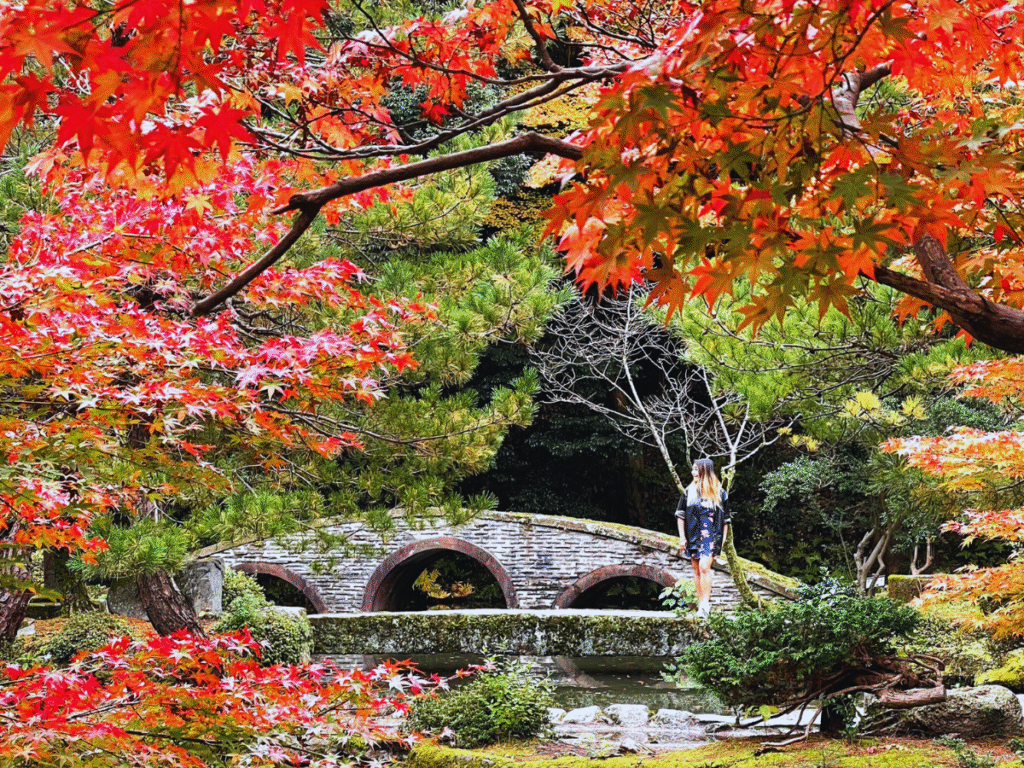
Kenrokuen isn’t just one of the top gardens in Japan — it’s a place that seems tailor-made for slow walks in a kimono. Designed around classic Japanese landscape principles, it changes beautifully with the seasons: cherry blossoms in spring, green calm in summer, vibrant reds in autumn, and soft snow in winter. Every corner feels thoughtfully arranged, from lantern-lit paths to tiny bridges over koi ponds.
Kimono rental shops nearby offer Kaga-style options — a regional take known for its subtle, painterly designs. Pairing that with a stroll through the garden makes for a perfectly poetic afternoon. It’s not just about photos (though you’ll definitely take a few); it’s about slowing down, feeling the rhythm of the place, and enjoying how nature and tradition blend together so seamlessly.
Higashi Chaya District (Kanazawa)
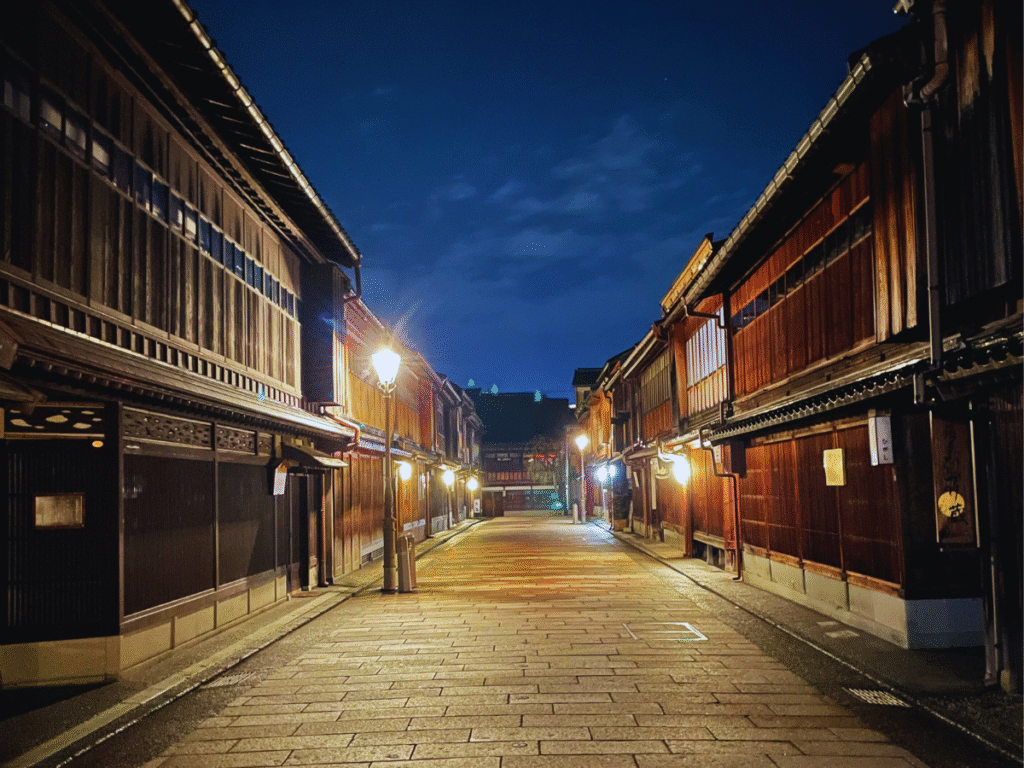
Higashi Chaya is one of Kanazawa’s preserved geisha districts, and it’s seriously atmospheric. The wooden buildings, narrow stone lanes, and latticed windows give the area a timeless feel — like the kind of place you’d expect to hear shamisen music drifting through the air. It’s smaller and quieter than Kyoto’s Gion, but that’s part of what makes it feel special.
Kimono rental shops are dotted around the area, and once you’re dressed, the streets become your runway. It’s the kind of setting where a kimono just fits — not in a touristy way, but in a “this makes sense here” way.
Don’t miss the little shops selling gold leaf (a local speciality) and handmade sweets, or the tea houses where you can sit down for a slow cup of matcha. It’s a great place for photos, but also just for taking your time and soaking it all in.
Asakusa & Senso-ji Temple (Tokyo)
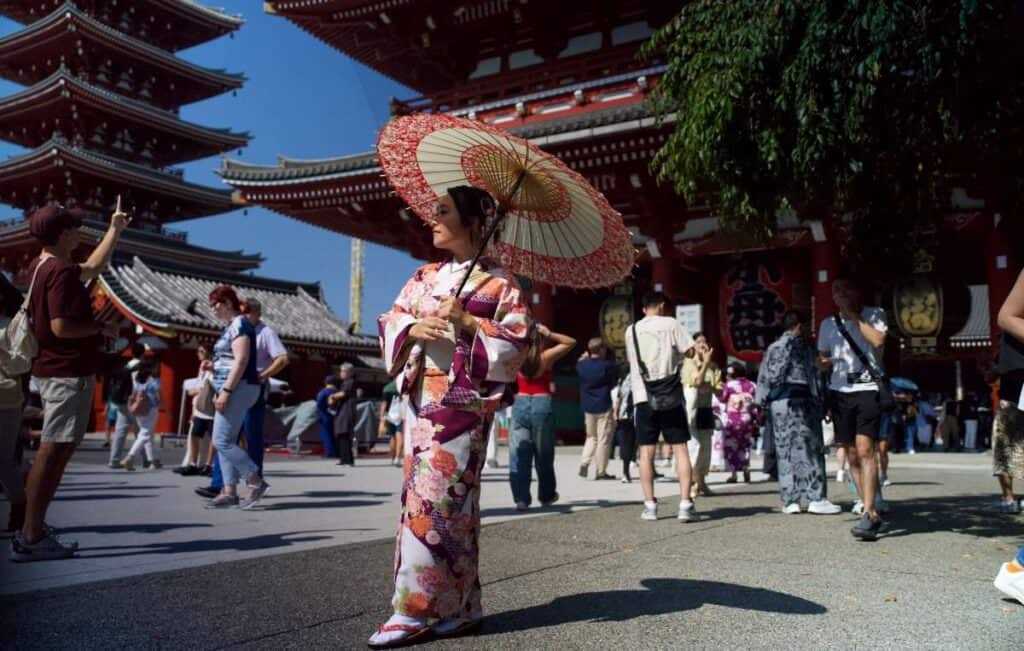
If you want the full “kimono in Tokyo” experience, this is where to do it. Senso-ji is Tokyo’s oldest and most famous temple, with bright red gates, giant lanterns, and streets full of stalls selling everything from taiyaki to souvenir chopsticks. The energy here is high — a mix of tradition, celebration, and street snacks — and it’s one of the easiest places to blend right in while dressed up.
You can book an Asakusa kimono experience through our website, offering both classic and modern kimono styles, plus hair styling and accessories if you want the full look. Once you’re dressed, stroll through Nakamise-dori (the main shopping street), explore the temple grounds, and wander down quieter side alleys for photos. It can get busy, but that just adds to the festive, buzzing vibe — it’s the kind of place where tradition and Tokyo’s fast pace meet in the best way.
Where to Shop, Make, and Collect Kimonos in Japan
Photos are great, but there’s something special about leaving Japan with a real piece of kimono culture in your hands.
Nishijin Textile Center (Kyoto)

Located in Kyoto’s historic weaving district, the Nishijin Textile Center is part museum, part shop, and part live demo space. Here, you can watch skilled weavers at traditional looms, get up close to intricate obi (kimono sashes), and even try on a full formal kimono for a photo session. It’s a great way to see how Kyoto’s famous Nishijin-ori textiles are made — rich, colourful, and seriously detailed.
The shop section is packed with fabric goods, from small souvenirs to full kimono and obi pieces. You don’t need a deep knowledge of textiles to enjoy it — just a love for craft and colour. It’s easy to access, free to enter, and a fun stop if you’re already exploring northern Kyoto.
Toji Temple Flea Market (Kyoto, 21st of each month)

If vintage kimonos are your thing (or you’re on the hunt for a serious bargain), don’t miss the flea market at Toji Temple. Held on the 21st of every month, it’s one of the biggest and most loved markets in Kyoto. The grounds fill up with stalls selling everything from antique fabrics and second-hand kimonos to ceramics, prints, and quirky collectables.
You’ll want to arrive early — especially if you’re after rare patterns or wearable pieces in good condition. Some vendors are experts, others just clearing out old wardrobes, so part of the fun is the treasure hunt. Even if you’re not shopping, it’s a fun, lively atmosphere with food stalls and all sorts of vintage finds.
Kimono Reborn Tokyo

Kimono Reborn is a creative, fashion-forward space that gives vintage kimono new life in completely modern forms. Instead of selling traditional full outfits, this Tokyo-based studio reworks old kimono fabrics — often decades or even a century old — into contemporary clothing and accessories.
Think button-up shirts made from soft silk with floral patterns, structured bags with traditional motifs, or reversible scarves made from vintage lining and outer fabric. Each piece is one of a kind, handmade, and designed to be worn in daily life, no special occasion needed.
It’s the perfect stop for anyone who loves the beauty of kimono textiles but doesn’t see themselves wearing the full ensemble. English-speaking staff are happy to explain the origins of each item — which fabric came from what era, what the motifs mean, and how the piece was constructed.
Ginza Motoji (Ginza, Tokyo)
If you’re serious about kimono, Ginza Motoji is a must-visit. This long-established kimono house is known for its craftsmanship, with a strong focus on made-to-order and regionally sourced pieces. Their collection includes both men’s and women’s kimono, along with a wide range of obi, haori, and formal accessories. Everything here is high quality — not just in materials, but also in the level of care that goes into styling, presentation, and customer support.
To ensure that an English-speaking staff can assist you during the visit, be sure to reach out to them in advance.
3min KIMONO (Tokyo & Online)

If you love the look of kimono but feel a bit overwhelmed by all the layers, ties, and rules — this one’s for you. At 3min KIMONO, you can actually make your own easy-wear version using real vintage kimono fabric. You start by choosing your favourite pattern from a gorgeous selection of pre-loved pieces, then cut and assemble it into a simplified kimono that you can slip on like a jacket. No sewing, no experience needed — it’s all done with scissors, glue, and step-by-step guidance.
The end result keeps the silhouette and style of a traditional kimono, but without the complex dressing process. It’s wearable, packable, and truly one of a kind. This is a great option if you want a hands-on experience and a personal, lasting souvenir — especially if the idea of wearing or styling a full kimono feels a bit intimidating. It’s modern, creative, and still deeply connected to tradition.
BOOK OFF (Nationwide)
For those looking to bring home a kimono without spending too much, BOOK OFF is a surprisingly good option. Many of the larger stores across Japan now have dedicated kimono sections, with racks of second-hand pieces in a wide range of styles and colours. Some even include accessories like obi, haori, and bags.
It’s also one of the more accessible places for non-Japanese speakers. Bigger branches often have signage in English and helpful staff, so browsing doesn’t feel intimidating. It’s an easy, low-commitment way to find something unique — perfect if you’re after a genuine kimono with a bit of history behind it.
What Exploring Kimono Culture Really Offers
Spending time with kimono — not just seeing it, but engaging with it — gives you a deeper view into Japanese culture than most experiences can. It’s not just about beautiful fabric or tradition for tradition’s sake. It’s about how Japan communicates identity, values, and artistry through clothing.
Luckily, kimono culture is also very accessible. You can walk into a second-hand shop and pick up a piece with history. You can stand in front of a 16th-century dyeing technique brought back to life by a single artisan. You can wear one for a day and suddenly notice how the architecture, the seasons, and the streets around you all start to feel different. You’re not just observing a tradition — you’re stepping into it, literally.



